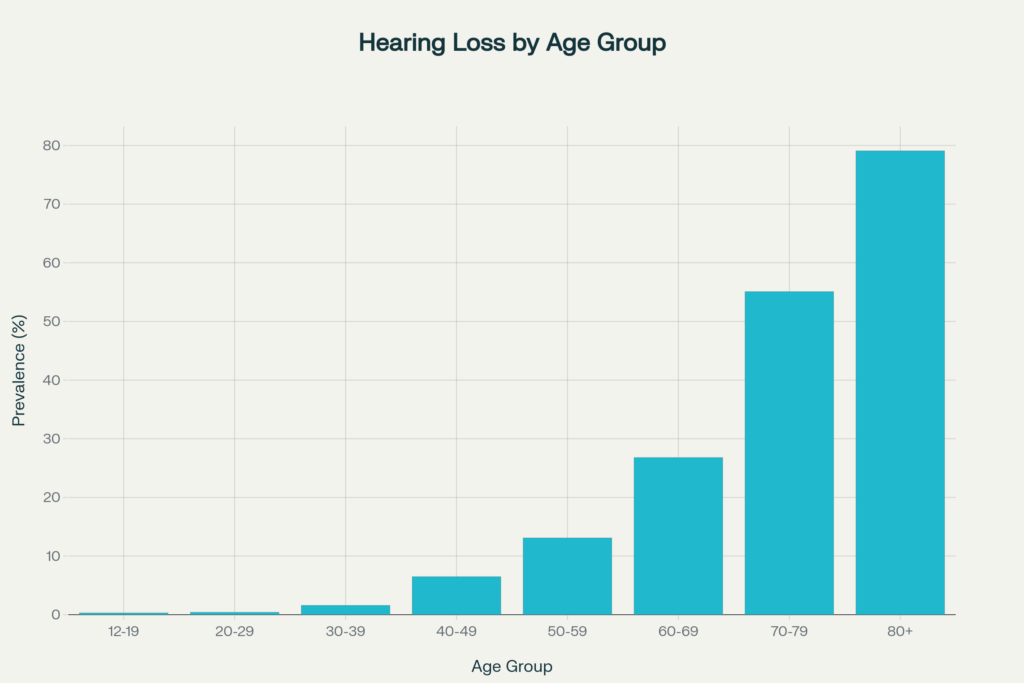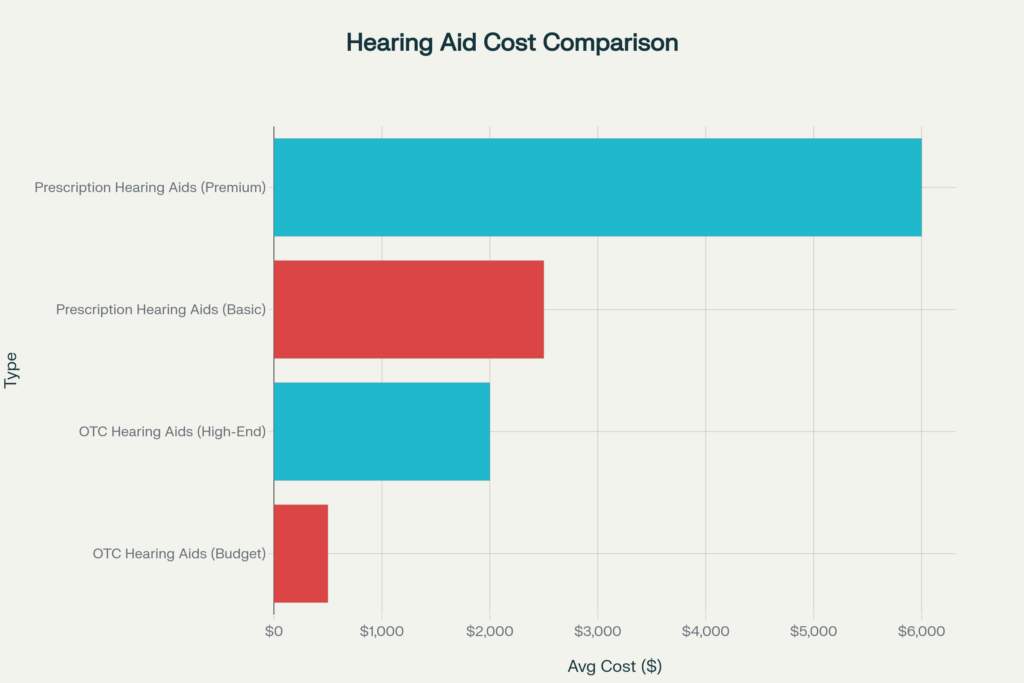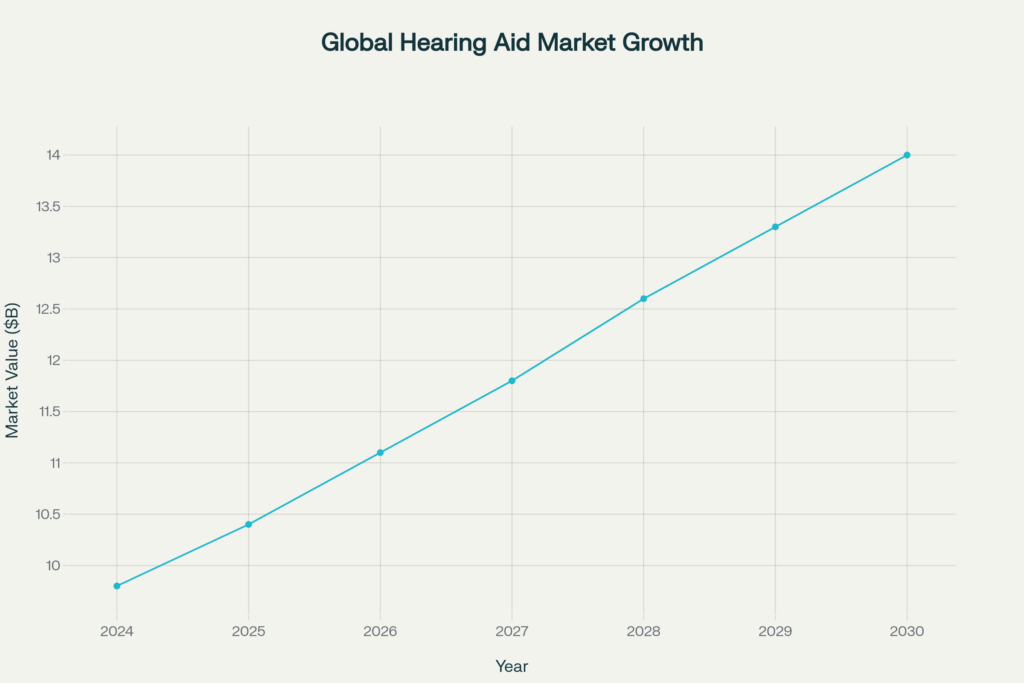The landscape of hearing healthcare has transformed dramatically in recent years, with technological advances making hearing aids more effective, accessible, and affordable than ever before. For the millions of Americans experiencing hearing loss, these devices represent not just improved hearing, but also significant benefits for cognitive health, social engagement, and overall quality of life. With hearing loss affecting approximately 41 million Americans, and projections indicating this number will reach 73.5 million by 2060, understanding modern hearing aid options and their preventive benefits is crucial for maintaining optimal health throughout life.
The Growing Impact of Hearing Loss in America
Hearing loss represents one of the most prevalent yet underaddressed health conditions in the United States. Current data reveals that approximately 15.5% of American adults, or 41 million people, experience some level of hearing loss. More concerning is that only 38.4% of those who could benefit from hearing aids actually use them, representing a significant gap in treatment that has far-reaching implications for public health.

Hearing Loss Prevalence Increases Dramatically with Age
The relationship between hearing loss and aging is particularly striking. While only 0.31% of individuals aged 12-19 experience hearing loss, this figure climbs dramatically with age. Among adults aged 40-49, 6.5% have hearing loss, rising to 26.8% for those 60-69, and reaching a staggering 79.1% for individuals over 80. This age-related pattern underscores the importance of early detection and intervention strategies in preventive medicine.
Demographic disparities also play a significant role in hearing loss prevalence. Men are more likely than women to experience hearing loss, with 8.9% of men aged 45 and older using hearing aids compared to 5.4% of women. Additionally, hearing loss is more common among white adults compared to Black or Hispanic populations, and individuals with lower education or economic means face higher rates of hearing impairment.
Understanding Modern Hearing Aid Technology and Types
Behind-the-Ear (BTE) Hearing Aids
Behind-the-ear hearing aids remain the most reliable and feature-rich option available today. These devices house all electronic components in a small case that rests behind the ear, connected to a custom earmold through flexible tubing. BTE hearing aids are particularly suitable for moderate to profound hearing loss and offer the most circuit options and capabilities available.
The advantages of BTE devices extend beyond their power capabilities. They are less susceptible to moisture and debris because the receiver remains outside the ear canal, making them particularly durable. For children, BTE hearing aids are often the preferred choice due to safety considerations and the ability to easily replace earmolds as the child grows.
Receiver-in-Canal (RIC) Hearing Aids
RIC hearing aids represent the most popular style currently available, combining discretion with advanced features. These devices position the speaker directly in the ear canal, connected to the main unit by a thin electrical wire. This design makes RIC hearing aids typically smaller and more discreet than traditional BTE models while maintaining excellent reliability and requiring minimal maintenance.
The popularity of RIC devices stems from their versatility. They are suitable for mild to severe hearing loss and can accommodate various ear canal sizes through different dome options. The placement of the receiver in the ear canal also provides more natural sound quality compared to traditional BTE devices.
In-the-Ear (ITE) and Custom Options
Custom hearing aids, including In-the-Ear (ITE), In-the-Canal (ITC), and Completely-in-Canal (CIC) models, are manufactured based on individual ear impressions. ITE hearing aids fill the outer portion of the ear and are often easier to handle than smaller devices, making them suitable for individuals with dexterity challenges.
The smallest custom options, including CIC and Invisible-in-Canal (IIC) devices, offer maximum discretion but may sacrifice some features due to size constraints. These devices are typically recommended for mild to moderate hearing loss and may not include advanced connectivity features found in larger models.
Breakthrough Technologies in 2025
Artificial Intelligence and Machine Learning
The integration of artificial intelligence represents the most significant advancement in hearing aid technology for 2025. Modern AI-powered hearing aids can make up to 80 million adjustments per hour, automatically adapting to changing acoustic environments. This technology enables devices to distinguish between different types of sounds and prioritize speech over background noise with unprecedented accuracy.
Machine learning algorithms allow hearing aids to adapt to individual preferences over time. These systems learn user preferences for volume levels, favorite voices, and environmental settings, creating increasingly personalized listening experiences. Some advanced models can automatically identify and track up to 6 people speaking within 6.5 feet, enhancing their voices while minimizing background interference.
Enhanced Connectivity and Streaming
Bluetooth LE Audio represents a major breakthrough in 2025, allowing users to stream premium audio with minimal battery usage. This advancement eliminates the traditional compromise between sound quality and battery life that has long plagued hearing aid users.
Modern hearing aids now offer compatibility with both iOS and Android devices, as well as smart TVs and home assistants like Alexa and Google Home. Advanced connectivity features include hands-free calling and the ability to stream audio from multiple devices simultaneously, making multitasking more convenient for users.
Rechargeable Battery Technology
The shift toward rechargeable batteries is transforming hearing aid convenience and sustainability. Modern rechargeable hearing aids can provide up to 51 hours of battery life on a single charge, with some models offering 29-39 hours of continuous use. This advancement reduces environmental waste while providing the convenience of long-lasting, portable power.
The Cognitive Health Connection: A Preventive Medicine Perspective
Hearing Aids as Cognitive Protection
Research has established a strong connection between hearing aid use and cognitive health preservation. A landmark study published in JAMA Neurology found that hearing aid users had a 19% lower risk of cognitive decline compared to non-users. Additionally, using hearing aids was associated with a 3% improvement in cognitive test scores, suggesting these devices may actively support brain health.
The most compelling evidence comes from recent randomized controlled trials. A major NIH-funded study found that hearing aids reduced the rate of cognitive decline by almost 50% over three years in older adults at high risk of dementia. This research followed nearly 1,000 adults aged 70-84 and represents the strongest evidence to date for hearing aids’ cognitive benefits.
Mechanisms of Cognitive Protection
The cognitive benefits of hearing aids likely operate through multiple mechanisms. Hearing loss forces the brain to work harder to process unclear auditory signals, diverting cognitive resources away from other mental tasks. By improving sound clarity, hearing aids reduce this cognitive load and free up mental resources for other functions.
Social isolation represents another critical pathway. Untreated hearing loss often leads to withdrawal from social situations, which is strongly associated with increased dementia risk. Hearing aids help maintain social engagement by improving communication ability, thereby reducing isolation-related cognitive decline.
Longitudinal research demonstrates that cognitive improvements can occur relatively quickly. One study found significant improvements in executive function equivalent to 13.2% of baseline scores after just 18 months of hearing aid use. Participants who used their hearing aids more than 90% of the time showed even greater improvements, with cognitive gains equivalent to 23.1% of baseline performance.
Cost Considerations and Insurance Coverage
Understanding Hearing Aid Costs
The cost of hearing aids varies significantly based on technology level and distribution method. Traditional prescription hearing aids typically range from $2,000 to $7,000 per pair, with premium models commanding the highest prices. These costs often include professional services such as fitting, programming, and ongoing maintenance.

Cost Comparison: Prescription vs. Over-the-Counter Hearing Aids
Over-the-counter (OTC) hearing aids, introduced by the FDA in 2022, provide a more affordable alternative for individuals with mild to moderate hearing loss. OTC devices typically cost between $100 and $2,500 per pair, making hearing assistance more accessible to a broader population.
Insurance Coverage Landscape
Insurance coverage for hearing aids remains limited but is slowly expanding. Traditional Medicare does not cover hearing aids, although it does pay for diagnostic hearing tests when ordered by a physician. However, Medicare Advantage plans increasingly offer hearing aid benefits, with coverage varying significantly by plan.
Private insurance coverage varies widely by employer and plan type. A recent survey found that 1 in 4 Americans have access to some degree of hearing aid coverage through their insurance. Government employees and those working for large corporations typically have better hearing aid benefits, sometimes receiving $1,000-$1,500 in coverage.
State-level differences also affect coverage. Twenty states require insurance companies to cover hearing aids for children, while four states mandate adult coverage. Medicaid coverage varies by state, with all states covering children’s hearing aids but adult coverage depending on individual state policies.
Over-the-Counter Hearing Aids: Expanding Access
FDA Regulatory Framework
The FDA’s establishment of the OTC hearing aid category in October 2022 represents a landmark change in hearing healthcare accessibility. This regulation allows adults 18 and older with perceived mild to moderate hearing loss to purchase hearing aids directly from stores or online without a prescription or audiologist fitting.
OTC hearing aids must meet specific FDA requirements for safety and effectiveness. These devices are limited to maximum output levels of 111 decibels to prevent additional hearing damage. The regulations also require comprehensive labeling to help consumers understand appropriate use and limitations.
Recent Technological Advances
The most significant recent development in OTC hearing aids is the FDA’s authorization of Apple’s AirPods Pro as a hearing aid device. This first-ever authorization of hearing aid software for consumer electronics represents a major step toward mainstream acceptance of hearing assistance technology.
This authorization enables compatible AirPods Pro to function as OTC hearing aids when used with Apple’s Hearing Aid Feature software. The development demonstrates how consumer electronics companies are entering the hearing aid market, potentially driving further innovation and cost reduction.
Prevention Strategies for Hearing Loss and Tinnitus
Noise-Induced Hearing Loss Prevention
Protecting hearing from excessive noise exposure remains the most effective prevention strategy for hearing loss. The Occupational Safety and Health Administration (OSHA) recommends that workplace noise exposure not exceed 85 decibels. To put this in perspective, normal conversation registers around 60 decibels, while a jet takeoff reaches 125 decibels.
Personal protective equipment (PPE) is essential in high-noise environments. This includes earplugs, earmuffs, or custom-fitted musician’s earplugs that reduce volume without muffling sound quality. Only about 8% of surveyed U.S. adults report using hearing protection at loud sporting or entertainment events, indicating significant room for improvement in prevention practices.
Lifestyle-Based Prevention
Taking regular “noise breaks” can help prevent hearing damage. Periodically stepping away from loud environments to quieter areas gives the auditory system time to recover. This simple strategy can help prevent the onset or worsening of tinnitus.
Maintaining overall health supports hearing preservation. A healthy lifestyle including balanced nutrition, regular exercise, and good cardiovascular health plays a role in preserving and promoting good hearing health. Certain conditions that affect circulation can contribute to hearing problems, making cardiovascular health particularly important.
Limiting headphone and earbud use at high volumes is crucial for younger generations. Smartphone applications can monitor environmental decibel levels, helping individuals make informed decisions about hearing protection needs.
The Economics of Hearing Healthcare
Market Growth and Innovation
The global hearing aid market is experiencing robust growth, with projections indicating expansion from $9.8 billion in 2024 to $14 billion by 2030. This represents a compound annual growth rate (CAGR) of 6.1%, driven by increasing awareness of hearing health and technological innovations.
Global Hearing Aid Market Projected to Reach $14 Billion by 2030:

Behind-the-ear hearing aids dominate the market, with projections showing this segment will reach $6.1 billion by 2030 with a CAGR of 7.6%. The receiver-in-the-ear segment is also experiencing strong growth at a 6% CAGR.
Regional variations in market growth reflect different healthcare systems and demographics. The U.S. market was valued at $2.6 billion in 2024, while China is expected to show remarkable growth at a 9.3% CAGR, reaching $3.3 billion by 2030.
Cost-Effectiveness Considerations
The economic benefits of hearing aid use extend beyond the individual user. Research suggests that addressing hearing loss through hearing aids provides significant healthcare cost savings by reducing risks of cognitive decline, depression, and falls. The World Health Organization estimates that unaddressed hearing loss poses an annual global cost of almost $1 trillion.
Investment in hearing healthcare shows strong returns. The WHO calculates that an annual additional investment of less than $1.40 per person globally would scale up ear and hearing care services, promising a return of nearly $16 for every dollar invested over a 10-year period.
Professional Care vs. Self-Service Options
The Role of Hearing Healthcare Professionals
Despite the availability of OTC options, hearing healthcare professionals remain essential for comprehensive hearing care. Audiologists provide services that extend far beyond device dispensing, including comprehensive hearing evaluations, medical referrals when appropriate, and ongoing rehabilitation support.
Professional fitting and programming significantly impact hearing aid success. Studies show that professionally fitted hearing aids achieve better outcomes in terms of user satisfaction and consistent use compared to self-fitted devices. The complexity of hearing loss often requires professional intervention to achieve optimal results.
When to Seek Professional Care
Certain conditions require professional evaluation before considering any hearing aid. These include sudden hearing loss, ear pain or drainage, excessive earwax, or hearing loss in only one ear. Children under 18 cannot use OTC hearing aids and require professional care.
Individuals with severe hearing loss need prescription hearing aids that offer more power and features than OTC devices can provide. Professional evaluation helps determine the appropriate level of technology needed for each individual’s specific hearing loss pattern and lifestyle requirements.
Future Directions and Emerging Technologies
Artificial Intelligence and Neural Networks
The future of hearing aids lies in increasingly sophisticated AI applications. Deep neural network (DNN) technology already enables some devices to process sound more naturally, but future developments promise even more advanced capabilities. Research into brain-computer interfaces (BCIs) suggests potential for hearing aids that adapt in real-time to users’ neural responses.
Connectivity and Smart Integration
Auracast™ technology represents the next frontier in hearing aid connectivity. This Bluetooth-based technology enables direct audio streaming in public spaces, allowing hearing aid users to receive clear audio from sources like airport announcements or gym televisions. As this technology expands into more public spaces, hearing aid functionality will become increasingly integrated into daily environments.
Personalized Medicine Approaches
Future hearing aids will likely incorporate genetic and biomarker information to provide truly personalized hearing solutions. Research into the genetic factors underlying hearing loss may enable prediction of hearing loss patterns and customization of amplification strategies based on individual genetic profiles.
Conclusion: Hearing Aids as Essential Healthcare Tools
Hearing aids have evolved from simple amplification devices to sophisticated healthcare tools that offer significant benefits for auditory, cognitive, and social health. With hearing loss affecting over 40 million Americans and this number expected to nearly double by 2060, access to effective hearing assistance has never been more critical.
The evidence for hearing aids’ cognitive protective effects is compelling, with research showing up to 50% reduction in cognitive decline rates among high-risk individuals. These findings position hearing aids not just as treatments for hearing loss, but as important tools in dementia prevention and overall healthy aging.
The introduction of OTC hearing aids has democratized access to hearing assistance, providing affordable options for individuals with mild to moderate hearing loss. However, professional hearing healthcare remains essential for comprehensive evaluation, medical clearance, and optimal device fitting.
For healthcare providers practicing preventive medicine, hearing health represents a crucial but often overlooked area. Regular hearing screenings, patient education about hearing protection, and timely referral for hearing aid evaluation should be standard components of preventive care, particularly for adults over 50.
The future of hearing healthcare is bright, with continued technological advances promising even more effective and accessible solutions. AI-powered sound processing, advanced connectivity features, and improved battery technology are making hearing aids more appealing to a broader range of users.
Most importantly, the growing body of research demonstrating hearing aids’ role in maintaining cognitive health underscores their value as preventive healthcare tools. For the millions of Americans with untreated hearing loss, hearing aids offer not just improved hearing, but potentially significant protection against cognitive decline and improved quality of life throughout the aging process.
As the population ages and hearing loss becomes increasingly prevalent, hearing aids will play an ever more important role in comprehensive healthcare. Healthcare providers, patients, and policymakers must work together to ensure these essential devices remain accessible and affordable for all who can benefit from them.